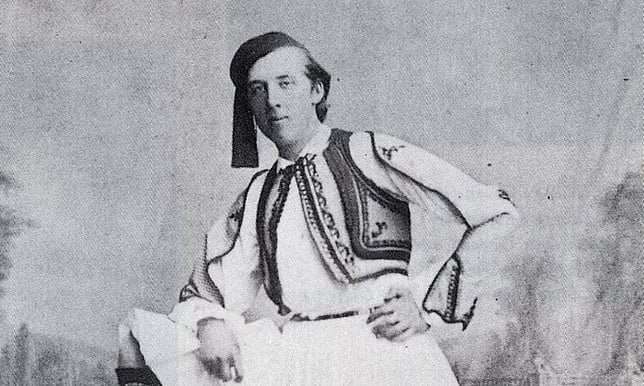
Famous Irish poet and playwright Oscar Wilde was in love with Greece and its culture and heritage, so in 1877 the 23-year-old, still a student at Oxford University, set out on a transformative journey through Greece—a voyage that would leave an indelible mark on his imagination and identity.
Already steeped in the language and lore of antiquity, Wilde had been captivated by Greek culture since childhood. His mother, the erudite Lady Jane Wilde, used to recite Aeschylus to him in the original Greek, planting early seeds of reverence for the classical world.
By the time he reached Oxford, Wilde was an accomplished Hellenist. He translated ancient texts with enthusiasm, delighting in the rigors of Greek syntax and grammar—even if he spoke the language with the stilted Erasmian accent typical of the time. His 1874 essay “The Social Life of Greece from Homer to Menander” revealed not only a scholarly mind but a romantic yearning for the golden age of antiquity.
Wilde’s intellectual pursuits, however, ran parallel to a personal struggle. Caught between Protestantism and Catholicism, the young Irishman was in search of a spiritual and aesthetic sanctuary. His Oxford mentor, the renowned classicist John Pentland Mahaffy—himself a lover of Greece—proposed a novel solution: instead of making the conventional pilgrimage to Rome, why not explore the cradle of Western civilization itself? Wilde agreed.
Oscar Wilde begins his odyssey in Greece
His first stop was Corfu, where he was enchanted by the turquoise sea, the warmth of the wine, and the island’s layered mythologies. So moved was he by the village of Agioi Deka (“Ten Saints”) that he composed a poem by the same name in April of 1877. It was a lament for the death of the old gods, now replaced by Christianity.
After Corfu, and a brief stay in Zakynthos, Wilde and his friends sailed to the mainland; their first landfall was at the seaside town of Katakolo in the Peloponnese, where Wilde wrote the poem “Impression de Voyage”.
The sea was sapphire coloured, and the sky
Burned like a heated opal through air,
We hoisted sail; the wind was blowing fair
For the blue lands that to the eastward lie.
From the steep prow I marked with quickening eye
Zakynthos, every olive grove and creek,
Ithaca’s cliff, Lycaon’s snowy peak,
And all the flower-strewn hills of Arcady.
The flapping of the sail against the mast,
The ripple of the water on the side,
The ripple of girls’ laughter at the stern,
The only sounds:—when ’gan the West to burn,
And a red sun upon the seas to ride,
I stood upon the soil of Greece at last!
The poem takes the form of a 14-line stanza. Wilde references parts of Greece he has seen in his journey: the Ionian Islands of Zakynthos and Ithaki (the Homeric Ithaca) and Mount Lykaion in Arcadia (which he refers to as Lycaon—the name of a mythical Arcadian hero and king).
On to Olympia, Argos and Athens
From there, he journeyed to Olympia, arriving just as groundbreaking archaeological excavations were revealing the treasures buried beneath centuries of earth.
Legend even suggests that Wilde was present when the statue of Hermes by Praxiteles was unearthed—a moment of divine serendipity for a youth obsessed with Greek beauty.
This was followed by a journey through the Peloponnese, during which they visited the village of Andritsaina and the nearby archaeological site of the Temple of Apollo Epicurius at Bassae, before continuing to the town of Argos and the world-renowned sites of Mycenae and Tiryns, the centre of the ancient Mycenaean civilisation, which was at the time being excavated by the team of famous German archaeologist Heinrich Schliemann
While in Argos, Wilde wrote the poem “The Theatre of Argos,” where he seems even more mournful at the bygone glory of Greek antiquity.
In Athens, Wilde “worshipped” the Acropolis, as he later described it. A now-famous photograph captures him in traditional Greek foustanella, taken by the photographer Petros Moraitis against a pastoral backdrop meant to evoke the classical countryside.

His final destinations included Epidaurus, Mycenae (where he observed the ongoing excavations led by Heinrich Schliemann), and the island of Aegina. The trip extended his absence from Oxford by three weeks, but it was a delay worth taking. Upon his return, Wilde passed his Greek and Latin philology course with distinction.
Oscar Wilde, the most significant representative of the Aesthetic Movement
One of the most popular books of the modern age, Oscar Wilde’s The Picture of Dorian Gray is among the most fascinating stories with roots in ancient Greek mythology and particularly in the story of Narcissus.
However, it’s not the story of Narcissus that The Picture of Dorian Gray reminds us of. Another Greek mythological figure, Adonis, could potentially be a source of inspiration for Wilde.
Wilde would go on to become a very successful author and the most significant representative of the Aesthetic Movement. He is mostly famous for his plays, such as Lady Windermere’s Fan, An Ideal Husband and The Importance of Being Earnest, which were performed with great success.
Other notable works include the story collections The Happy Prince and Other Stories and Lord Arthur Savile’s Crime and Other Stories.

